Public housing

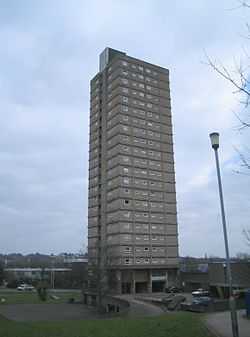
Public housing is a form of housing tenure in which the property is owned by a government authority, which may be central or local. Social housing is an umbrella term referring to rental housing which may be owned and managed by the state, by non-profit organizations, or by a combination of the two, usually with the aim of providing affordable housing. Social housing can also be seen as a potential remedy to housing inequality.
Although the common goal of public housing is to provide affordable housing, the details, terminology, definitions of poverty and other criteria for allocation vary within different contexts.
History
The origins of municipal housing lie in the dramatic urban population increase caused by the Industrial Revolution of the 19th century. In the large cities of the period, many social commentators, such as Octavia Hill and Charles Booth reported on the squalor, sickness and immorality that arose. Henry Mayhew, visiting Bethnal Green, wrote in the Morning Chronicle:
roads were unmade, often mere alleys, houses small and without foundations, subdivided and often around unpaved courts. An almost total lack of drainage and sewerage was made worse by the ponds formed by the excavation of brickearth. Pigs and cows in back yards, noxious trades like boiling tripe, melting tallow, or preparing cat's meat, and slaughter houses, dustheaps, and 'lakes of putrefying night soil' added to the filth.[2]
Some philanthropists began to provide housing in tenement blocks, while some factory owners built entire villages for their workers, such as Saltaire in 1853 and Port Sunlight in 1888. It was in 1885, after the report from a Royal Commission in England, that the state first took an interest. This led to the Housing of the Working Classes Act of 1885, which empowered Local Government Boards to shut down unhealthy properties and encouraged them to improve the housing in their areas.
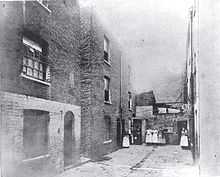
The first public housing project in the world[3] was at one of the most notorious slums of London - the Old Nichol.[4] Nearly 6,000 individuals were crammed into the packed streets, where one child in four died before his or her first birthday. Arthur Morrison wrote the influential A Child of the Jago, an account of the life of a child in the slum, which sparked a public outcry. Construction for a public housing estate was begun in 1890 by the Metropolitan Board of Works and completed by the recently formed London County Council in 1900.[5]
The success of this project spurred many local councils to embark on similar construction schemes in the early twentieth century. The First World War indirectly provided a new impetus, when the poor physical health and condition of many urban recruits to the army was noted with alarm. This led to a campaign known as Homes fit for heroes and in 1919 the Government first compelled councils to provide housing, helping them to do so through the provision of subsidies, under the Housing Act 1919.[6] Public housing projects were tried out in some European countries and the United States in the 1930s, but only became widespread globally after the Second World War.
Americas
Brazil
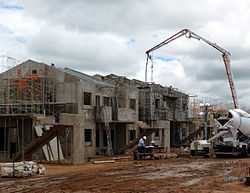
Minha Casa Minha Vida (My House, My Life), the Brazilian government's social housing program, was launched in March 2009 with a budget of R$36 billion (US$18 billion) to build 1 million homes.[7] The second stage of the program, included within the government Growth Acceleration Program (PAC - Programa de Aceleração do Crescimento) was announced in March 2010.[8] This stage foresees the construction of a further 2 million homes.
Of the total 3 million homes, 1.6 million are for families earning between 0 and 3 times the monthly minimum wage (R$545); 1 million homes are allocated to families with salaries between 3 and 6 times the monthly minimum wage; and the remaining 400,000 homes are for families earning between 6 and 10 times the monthly minimum wage. All funds for Minha Casa Minha Vida properties are provided by the Brazilian public bank, Caixa Econômica Federal.[9] The bank finances development and provides mortgages for qualifying families.
In April 2011, the Minister for Planning, Miriam Belchior announced that 1 million homes were contracted for the Minha Casa Minha Vida in 2010 and that 500,000 homes would be delivered in 2011. The government budget for the programme was R$39 billion in 2010 and R$40.1 billion in 2011.[10]
Canada
In Canada, public housing is usually a block of purpose-built subsidized housing operated by a government agency, often simply referred to as projects or community housing, with easier-to-manage town houses. Canada, especially Toronto, still maintains large high-rise clustered developments in working-class neighborhoods, a system that has fallen into disfavor in both the UK and US. However, Toronto Community Housing, one of the largest public housing agencies in North America, has a variety of buildings and communities ranging from individual houses to townhouse communities and mid-rise and high-rise apartments in both working-class and middle-class neighborhoods. They house low-income Canadians.
Following the decentralisation of public housing to local municipalities, Social Housing Services Corporation (SHSC) was created in the Province of Ontario in 2002 to provide group services for social housing providers (public housing, non-profit housing and co-operative housing). It is a non-profit corporation which provides Ontario housing providers and service managers with bulk purchasing, insurance, investment and information services that add significant value to their operations.
Recently, there has been a move toward the integration of public housing with market housing and other uses. Revitalization plans for properties such as in the notorious Downtown Eastside of Vancouver, and Regent Park, Lawrence Heights, and Alexandra Park in Toronto, aim to provide better accommodations for low-income residents, and connect them to the greater community. In Toronto, for instance, the aims of the reconstruction plans of Regent Park are to better integrate it into the traditional grid of streets, improve leisure and cultural amenities, and construct mixed-income buildings. However, the residents of these communities have had little effective input in the plans and have had mixed reactions to the construction.
A plan to house Vancouver's homeless is taking shape on the drawing board of a local architect. It calls for the rapid erection of temporary villages assembled from the same type of modular units that mining companies provide for remote workers. "Stop Gap Shelters" is what architect Gregory Henriquez calls it. "All of us in this community have long been advocates for permanent housing," he said. "But we've gotten to the point where the numbers of homeless are so staggering that I'm left wondering if we will ever catch up doing it that way. I don't think we can. I think there has to be a stop-gap measure. And that's what this is." Henriquez drew up plans for a motel-like village, with 48 suites clustered around a central courtyard. The colourful compound includes a managers' office, a covered patio, and a second storey meeting room all within a typical 120-by-200-foot city lot.[citation needed]
Mexico
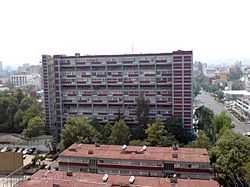
At the end of the Second World War, enriched by US investments and an oil boom, Mexico had its first demographic boom, in which the primary destination for rural immigrants was Mexico City. Mario Pani Darqui, a famous architect at time, was charged to build its first big scale projects. Built for the Dirección de Pensiones Civiles y Retiro (the National Pensions office, today ISSSTE), the Centro Urbano (or Multifamiliar) Miguel Alemán (1947–50) and the Centro Urbano (or Multifamiliar) Benito Juárez (1951–52), both in the Colonia Roma, introduced formal ideas from Le Corbusier's Ville Radieuse into the urban fabric.
His later project, the Conjunto Urbano Tlatelolco Nonoalco built in 1960-65, was meant to develop one of the poorest parts of the city, Santiago Tlatelolco, which was becoming a slum. Unfortunately, after a while, instead of giving the residences to the previous residents of Tlatelolco, corruption took place and most of the dwellings were handed to state employees.
During the earthquake of 1985 both the Benito Juárez and Nonoalco-Tlaltelolco complexes suffered major damage, with some buildings collapsing. Today most of the Multifamiliar Benito Juárez has been demolished.
But after all, Mexico has had experience of housing projects since Porfirio Díaz's regime, one of those, still remains and is the Barrio of Loreto in San Ángel, Álvaro Obregón, D.F., that was a project for a paper factory workers.
Puerto Rico
United States
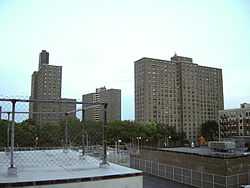
In the nineteenth and early twentieth centuries, government involvement in housing for the poor was chiefly in the introduction of buildings standards. New York City's First Houses, dedicated in 1935, were the nation's first public housing project.[11] Most housing communities were developed from the 1930s onward and initial public housing was largely slum clearance, with the requirement insisted upon by private builders that for every unit of public housing constructed, a unit of private housing would be demolished.
This also eased concerns of the establishment by eliminating or altering neighborhoods commonly considered a source of disease, and reflected progressive-era sanitation initiatives. Moreover, public housing along with the Federal Highway Program demolished the older, sub-standard housing of communities of color across the United States.
However, the advent of makeshift tent communities during the Great Depression caused concern in the Administration. Public housing in its earliest decades was usually much more working-class and middle-class and white than it was by the 1970s. Many Americans associate large, multi-story towers with public housing, but early projects were actually low-rise, though Le Corbusier superblocks caught on before World War II.
A unique US public housing initiative was the development of subsidized middle-class housing during the late New Deal (1940–42) under the auspices of the Mutual Ownership Defense Housing Division of the Federal Works Agency under the direction of Colonel Lawrence Westbrook. These eight projects were purchased by the residents after the Second World War and as of 2009 seven of the projects continue to operate as mutual housing corporations owned by their residents. These projects are among the very few definitive success stories in the history of the US public housing effort.
There are also many New York City Housing Authority (NYCHA) efforts that have provided in-demand and inexpensive public housing for decades, see "Public Housing That Worked: New York in the Twentieth Century" by Nicholas Dagen Bloom for a rigorous examination of the U.S. public housing management agency with the country's most extensive holdings. Bloom's "Public Housing" dispels common U.S. public housing myths while detailing advances made by NYCHA, see also NYCHA's own website "Fact Sheet" for elucidation of the magnitude and scope of their work since 1934.
Public housing was only built with the blessing of the local government, and projects were almost never built on suburban greenfields, but through regeneration of older neighborhoods. The destruction of tenements and eviction of their low-income residents consistently created problems in nearby neighborhoods with "soft" real estate markets. Houses, apartments or other residential units are usually subsidized on a rent-geared-to-income (RGI) basis. Some communities have now embraced a mixed income, with both assisted and market rents, when allocating homes as they become available.
The federal Housing and Urban Development (HUD) department's 1993 HOPE VI program addressed concerns of distressed properties and blighted superblocks with revitalization and funding projects for the renewal of public housing to decrease its density and allow for tenants with mixed income levels.[12][13] Projects continue to have a reputation for violence, drug use, and prostitution, especially in New Orleans, New York City, Philadelphia, Los Angeles, Chicago, and Washington, D.C. as well as others leading to the passage of a 1996 federal "one strike you're out" law, enabling the eviction of tenants convicted of crimes, especially drug-related, or merely as a result of being tried for some crimes.[14]
Other attempts to solve these problems include the 1978 Section 8 Housing Program, which encourages the private sector to construct affordable homes, and subsidizes public housing. This assistance can be "project-based", subsidizing properties, or "tenant-based", which provides tenants with a voucher, accepted by some landlords.
Asia
China
In mainland China, the government provides public housing through various sources, such as new housing, abandoned properties, and old flats which are rented at a low price and called 'Lian Zu Fang' (literally 'low-rent house' or 'low-rent housing', Chinese: 廉租房). Additional housing is built by providing free land and exemption from fees to estate developers: the resulting houses are called 'Jing Ji Shi Yong Fang' (literally 'the economically affordable Housing', Chinese: 经济适用房).
The concept of the low-cost rental housing can be traced to a 1998 policy statement, but did not truly take off until 2006 due to limited funding and administrative problems. The provision of more affordable housing is one of the key components of China's Twelfth Five-year Plan, which targets the construction of 36 million homes by 2015. That program's costs will be split between the private and public sector and are estimated at five trillion yuan by Chinese investment bank CICC.[15]
Hong Kong
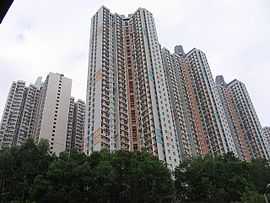
In Hong Kong, public housing is one of the major housing policies of the government. Nearly half of Hong Kong's 7.8 million population lives in public housing.[1]
Japan
Singapore
In Singapore, the public housing program, particularly the planning and development of new public housing and the allocation of rental units and resale of existing ownership units, is managed by the Housing and Development Board. Day-to-day management of public housing communities has largely been delegated to Town Councils headed by the local Members of Parliament.
Most of the residential housing developments in Singapore are publicly governed and developed. Most of the residents in public housing are tenants under a 99 year lease agreement.
Europe
Austria

Gemeindebau (plural: Gemeindebauten) is a German word for "municipality building". In Austria, it refers to residential buildings erected by a municipality, usually to provide low-cost public housing. These have been an important part of the architecture and culture of Vienna since the 1920s.
Finland
The earliest public housing project in Finland was in Helsinki. In 1909, four wooden houses designed by the architect A. Nyberg were built on Kirstinkuja (formerly Kristiinankatu) for the city’s workers. The residents were mainly working-class families with several children. The apartments had an average of five people per room, sometimes up to eight. The tiny apartments were equipped with running water, a pantry and an attic cupboard. Every apartment had its own toilet in the cellar. Electric lighting was installed in 1918.
The homes and lives of worker families in Helsinki from 1909 to 1985 are presented in a museum near the Linnanmäki amusement park.
France

After World War II, the population increased at a rate previously unknown, the rural exodus increased, while war damage had reduced the number of houses in many cities. Rental prices dramatically rose, and the government made a law in 1949 to block them, effectively ending the economic benefits of housing investment. Additionally, construction was heavily regulated which made building difficult without political support.
The government launched a major construction plan, including the creation of new towns ("villes nouvelles") and new suburbs with HLM (Habitation à Loyer Modéré, "low-rent housing"). The state had the funds and the legal means to acquire the land and could provide some advantages to the companies that built its huge housing complexes of hundreds of apartments. Quality was also effectively regulated, resulting in decent or even top quality housing for the standard of the 1950s and 1960s. The construction of HLMs were subject to much political debate.
HLM construction was also a major (and illegal) source of political financing: building companies had to pay back the political party of the mayor that launched an HLM program. This resulted in corruption and some scandals.[citation needed]
France still retains this system, a recent law making it an obligation for every town to have at least 20% HLM. Nowadays HLM represents roughly half of the rental market (46% in 2006).[16]
While they succeeded in giving lower-income families a place to live, this system also led to the creation of suburban ghettos. There, deprived strata of the population, mostly of immigrant origin and suffering massive under-employment, were left to simmer away from the more affluent urban centres, sometimes becoming rife with social tensions and violence. Tackling this problem at its roots is all but simple, with a lack of success despite many plans, so that a blind "law-and-order" attitude is now common in French internal politics, with few effective results and violent symptoms.[citation needed]
Germany
Between 1925 and 1930 Germany was the site of innovative and extensive municipal public housing projects, mostly in Berlin, Hamburg, Cologne and Frankfurt am Main. These Siedlungen (settlements), were made necessary by the dreadful living conditions of pre-war urban tenements. The right to a healthy dwelling was written into the 1919 Weimar Constitution, but few dwellings were built until economic stability in 1925.
These settlements were low-rise, no more than 5 stories, and in suburban settings. Residents were provided access to light, air, and sun. The size, shape, orientation and architectural style of Germany's public housing were informed by the recent experience of the Vienese and the Dutch, the anti-urban Garden City Movement in Britain, by new industrialized mass-production and pre-fabrication building techniques, by the novel use of steel and glass, and by the progressive-liberal policies of the Social Democrats.
Architect Martin Wagner (with Bruno Taut) was responsible for the thousands of dwellings built in and around Berlin, including the Horseshoe Siedlung (named for its shape), and Uncle Tom's Cabin Siedlung (named for a local restaurant). But Wagner was second to the city planner Ernst May in Frankfurt. May was responsible for the construction of 23 separate settlements, 15,000 total units, in five years. He ran his own sizable research facility to investigate, for instance, air-flow in various floorplan configurations, construction techniques, etc. The Austrian architect Margarete Schütte-Lihotzky applied the principles of Taylorism to the kitchen workspace and developed the Frankfurt kitchen while working for Ernst May.

Beyond technical research May also published two magazines and embarked on a significant public-relations project, with films and classes and public exhibitions, to make Neues Bauen acceptable to the public. In the late 1920s the principles of equal access to "Licht, Luft und Sonne" and the social effects of a guaranteed "Existenzminimum" became a matter of lively popular debate all over Germany. One indirect result of this publicity was the American housing movement: a young Catherine Bauer attended one of May's conferences in 1930, and wrote her seminal "Modern Housing" based on research done in Frankfurt and with Dutch architect JJP Oud.
Increasing pressure from the rising Nazis brought this era to an end in 1933. A majority of the German public housing experts had Social Democrat or Communist sympathies and were forced out of the country.
In East Germany, Communist administration saw the rise of the Plattenbau ("panel building"). Virtually all new residential buildings since the 1960s were built in this style, as it was a quick and relatively cheap way to solve the country's severe housing shortage, which had been caused by wartime bombing raids and the large influx of German refugees from further east.
There were several common plattenbau designs. The most common series was the P2, followed by the WBS 70. the WHH GT 18, and Q3A. The designs were flexible and could be built as towers or rows of apartments of various heights.
Hungary
Panelház (short form: panel) is the name of a type of block of flats (panel buildings) in Hungary. It was the main housing type built in the Socialist era. From 1959 to 1990 788,000 panel flats were built in Hungary. About 2 million people, about one fifth of the country's total population, live in these flats. The Hungarian and local municipalities began a renovation program during the 2000s. In the program they have insulated these buildings, replaced the old doors and windows with multi-layer thermo glass, renewed the heating system and colored the buildings in a more pleasant way.[17]
Ireland
In Ireland, public housing and halting sites (sites used by semi-nomadic Traveller communities) have been built by local authorities and are known as local authority accommodation. Dublin Corporation and the former Dublin County Council provided the lion's share of Irish local authority housing, with County Longford having the largest ratio of local authority to private housing in the state. The government has promoted tenant purchase on favourable terms, and many former social housing areas are now completely or almost completely privately owned. Housing associations now play a significant role in social housing provision. As the Irish state's ability to borrow is diminished government policy favours an increased role for private financing of housing associations instead of capital grants for local authorities.
Netherlands
In the Netherlands, the rent for the cheaper rental homes is kept low through governmental oversight and regulation. These types of homes are known as sociale huurwoningen.
In practice this is accomplished by non-profit private housing foundations or associations (toegelaten instellingen). Due to frequent mergers the number of these organizations dropped to around 430 (2009). They manage 2.4 million dwellings. The majority of the low-rent apartments in the Netherlands are owned by such organisations. Since the policy changed in 1995 the social housing organizations have become financially independent focusing on their role as social entrepreneurs. In most Dutch municipalities there came to exist a certain minimum capacity of social housing throughout the last decades. In many cities such as Amsterdam, The Hague, Rotterdam and Utrecht the percentage of social housing approaches or even passes 50 percent. The public (financial) supervision is done by the central fund for housing (Centraal Fonds Volkshuisvesting).
The Dutch housing policy is based on a concept of universal access to affordable housing for all and the prevention of segregation.
Romania
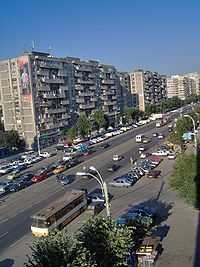
The skyline of many Romanian cities became dominated by standardized apartment blocks under the former communist government's policy of tower bloc construction. Beginning in 1974, systematization consisted largely of the demolition and reconstruction of existing villages, towns, and cities, in whole or in part, with the stated goal of turning Romania into a "multilaterally developed socialist society".
Former Soviet Union
In the Soviet Union, most of the houses built after World War II were usually 3–5 stories high, with small apartments. In these boroughs, the goal was saving space and creating as many apartments as possible. Construction starting in the 1970s favored 9- and 16-story concrete panel municipal housing in major cities, 7–12 stories in smaller urban areas.
Spain

Spaniards' aversity to rental homes, and government spending cuts in the 1980s, reduced rented public housing in Spain to a minimum. Rented public houses were relatively common in the Franco era (1936–75). With the advent of democracy and the 1978 Constitution, the management of social housing depended mostly on the autonomous regions. This resulted in a wide variety of laws, which make the issue highly dependent on the region.
In spite of this, a scheme for viviendas de protección oficial (VPO) has been widely used, consisting of local councils allowing for building contractors and developers to build in public sites or with public loans on condition that a certain percentage of apartments remain subsidized and under control of the local authorities. This is known as VPO de promoción privada, as opposed to the VPO de promoción pública, in which the whole property is owned and managed by a government authority.
A new plan ("Plan estatal español de vivienda y rehabilitación para el período 2009-2012") was put forward by the Rodríguez Zapatero government, aiming to make near a million homes available for public housing, relying both on new construction and refurbishment of unused houses.
Sweden
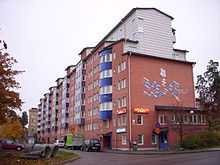
The Swedish public housing is called 'Allmännyttigt bostadsföretag', which is mostly made out of flats owned by the local council. In difference towards its counterparts in for instance Great Britain, the Swedish Public Housing has never had any income restrictions. Instead, for large parts of the period between 1920-1990 (for instance, during the era of Miljonprogrammet), the public housing companies such as Svenska Bostäder were the major operators in housing projects as well as in projects aiming to acquire old and worn down buildings. Although not carrying out housing nor acquisitional projects in recent times, the policies lead to a ubiquitous presence of publicly owned buildings throughout the cities of Sweden, including attractive urban areas, with a rather wide range of income among the tenants.
Policies carried out in the Swedish cities throughout the first decade of the 21st century have led to the tenants of public housing having bought the publicly owned buildings in which they live, which in turn has led to a significant decrease of publicly owned buildings in attractive urban areas, subsequently leading to an increased development of processes related to gentrification.
United Kingdom
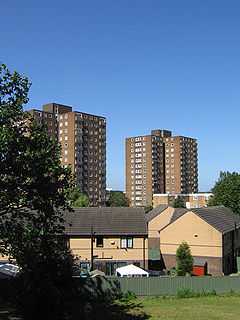
In the United Kingdom public housing is often referred to by the British public as "council housing" and "council estates", based on the historical role of district and borough councils in running public housing. Mass council house building began in about 1920 in order to replace older and dilapidated properties.[6]
Housing was an issue the Conservatives made their own, after the Churchill government of the early 1950s, with Harold Macmillan as Minister for Housing, gave housing construction far higher political priority than it had received before. Under the Attlee Labour government housing was attached to the portfolio of Health Minister Aneurin Bevan, whose attention was concentrated on his responsibilities for the National Health Service. Macmillan had accepted Winston Churchill's challenge to meet the latter's ambitious public commitment to build 300,000 new homes a year, and achieved the target a year ahead of schedule.
Housing was a major policy area under Wilson's Labour government, 1964 to 1970, with an accelerated pace of new building, as there was still a great deal of unfit housing needing replacement. Tower blocks, first built in the 1950s, featured prominently in this era. The proportion of council housing rose from 42% to 50% of the nation's housing total,[18] while the number of council homes built increased steadily, from 119,000 in 1964 to 133,000 in 1965 and to 142,000 in 1966.
Allowing for demolitions, 1.3 million new homes were built between 1965 and 1970.[19] To encourage home ownership, the government introduced the Option Mortgage Scheme (1968), which made low-income house buyers eligible for subsidies (equivalent to tax relief on mortgage interest payments).[20] This scheme had the effect of reducing housing costs for buyers on low incomes.[21]
Since the 1970s, non-profit housing associations have been operating an increasing share of social housing properties in the United Kingdom. From 1996 they have also been known as Registered Social Landlords (RSLs), and public housing has been referred to as "social housing" to encompass both councils and RSLs. Despite being non-profit based, RSLs generally charge higher rents than councils. However, the Government introduced a "rent re-structuring" policy in 2002, which aimed to bring council and RSL rents into line in England by 2012.[22] Local planning departments may require private-sector developers to offer "affordable housing" as a condition of planning permission (section 106 agreement). This accounts for another £700m of Government funding each year for tenants in part of the United Kingdom. As of 2012, Housing Associations are now also referred to as "Private Registered Providers of Social Housing" (PRPs).[23]
Local authorities have been discouraged from building council housing since 1979 following the election of Conservative leader Margaret Thatcher as prime minister. The Parker Morris standard was abolished for those that were built, resulting in smaller room sizes and fewer facilities. And the Right to Buy was introduced, resulting in the move of some of the best stock from public tenanted to private owner occupation.
Since the year 2000, "choice-based lettings" (CBL)[24] have been introduced to help ensure social housing was occupied speedily as tenants moved. This can still favour the local over the non-local prospective tenant. In a number of local authority areas, due to the shortage of council housing, three out of four properties may be designated for priority cases (those living in poor overcrowded conditions, with medical or welfare needs, or needing family support) or homeless applicants in order to meet the councils’ legal obligations to rehouse people in need. The percentage of properties set aside for vulnerable groups will vary dependent on the demand for council housing in the area. All local authorities have a Housing Strategy[25] to ensure that council houses are let fairly and fulfil the council's legal obligations; deal with people in need; and contribute to sustainability of housing estates, neighbourhood regeneration, and social inclusion.

The 1997–2010 Labour Government wished to move council housing away from local authority management. At first, this was through Large Scale Voluntary Transfers (LSVT) of stock from councils to Housing Associations (HAs). Not all council property could be transferred, as in some local authorities, their housing stock was in poor condition and had a capital value less than the remaining debts from construction costs—in effect, the council stock was in negative equity.[26] In some local authority areas, the tenants rejected the transfer option.[27]
The Labour Government introduced a "third way": the Arms Length Management Organisation (ALMO), where the housing stock stays with the Local Authority but is managed by a not-for-profit organisation at arm's length from the Local Authority. It also introduced the Decent Homes programme, a capital fund to bring social housing up to a modern physical standard. To use this fund, the manager, whether ALMO or HA, had to achieve a 2 or 3 star rating from its inspection by the Audit Commission.[28] This was intended to drive up management standards. Council landlords cannot access this funding, another incentive to transfer management of council housing to an ALMO or HA.
Governments since the early 1990s have also encouraged "mixed tenure" in regeneration areas and on "new-build" housing estates, offering a range of ownership and rental options, with a view to engineering social harmony through including "social housing" and "affordable housing" options. A recent research report[29] has argued that the evidence base for tenure mixing remains thin.
Most UK social housing tenants have the right to swap homes with another tenant even if their landlords are different. This is called a "mutual exchange".
Oceania
Australia

Public housing in Australia is usually provided by departments of state and territory governments, with funding provided by both state and federal governments. There are over 300,000 public housing dwellings in Australia, consisting of low-density housing on master-planned estates located in suburban areas, and also inner-city high-rise apartments in Melbourne and Sydney.
In recent decades, rooming and relief housing for the homeless has been privatised, and in recent years this housing has been sold off to avoid maintenance costs and capitalise on sales in a booming property market. In Melbourne, public housing stocks have been in decline for some time.
New Zealand
In New Zealand, public housing, known as state housing, was introduced by the Government in 1937 for citizens unable to afford private rents. Following WWII, most local authorities also started providing social housing, mainly for elderly people with low incomes.
See also
| Wikimedia Commons has media related to Public housing. |
- Affordable housing
- Fuggerei (The world's oldest social housing complex still in use.)
- Subsidised housing
General:
Notes
- ↑ 1.0 1.1 Hong Kong Census and Statistics Department – Population by type of housing The government provides public housing through flats which are rented at a lower price than the markets, and through the Home Ownership Scheme, which are sold at a lower price. These are built and administered by the Hong Kong Housing Authority and the Hong Kong Housing Society.
- ↑ 'Bethnal Green: Building and Social Conditions from 1837 to 1875', A History of the County of Middlesex: Volume 11: Stepney, Bethnal Green (1998), pp. 120-26 accessed: 14 November 2006.
- ↑ "BOUNDARY OF OLD NICHOL’S VICE, FILTH & DEATH".
- ↑ The London, 12 March 1896 To Check the Survival of the Unfit accessed 13 November 2006
- ↑ 'Bethnal Green: Building and Social Conditions from 1876 to 1914', A History of the County of Middlesex: Volume 11: Stepney, Bethnal Green (1998), pp. 126-32 accessed: 14 November 2006.
- ↑ 6.0 6.1 Hollow, Matthew (2011). "Suburban Ideals on England's Interwar Council Estates". Retrieved 2012-12-29.
- ↑ ,"Bloomberg", July 30, 2009
- ↑ Blogs World Bank,"Brazil Announces Phase Two of the Growth Acceleration Program", March 30, 2010
- ↑ "Caixa Econômica Federal
- ↑ "Minha Casa Minha Vida Will Deliver 500,000 Homes This Year", April 26, 2011
- ↑ "New York City Housing Authority". The City of New York. Retrieved 2011-11-16. "Dedication ceremonies for First Houses, December 3, 1935 - First Lady Eleanor Roosevelt cuts the ceremonial ribbon at the landmark opening of the first public housing development in the United States."
- ↑ "Hope VI funds new urban neighborhoods". New Urban News. Jan.-February 2002. Retrieved 2011-11-16.
- ↑ "HUDNo.10-112/U.S. Department of Housing and Urban Development (HUD):". HUD. June 2010. Retrieved 2011-11-16.
- ↑ Application of First Strike Policy Is Questioned By ANGELA CAPUTO, New York Times, September 3, 2011
- ↑ Sun Jianfang (October 24, 2011) Will Housing Projects Boost GDP? The Economic Observer Quarterly. Retrieved December 9, 2011.
- ↑ "Quelques données chiffrées sur le parc locatif privé [fr]"
- ↑ "General information on various student flats and building types in Budapest". Budapest Corner. Retrieved 2010-12-11.
- ↑ A Short History of the Labour Party by Alastair J. Reid and Henry Pelling
- ↑ Thorpe, Andrew. (2001) A History Of The British Labour Party, Palgrave, ISBN 978-0-333-92908-7
- ↑ Housing policy: an introduction by Paul N. Balchin and Maureen Rhoden
- ↑ Capitalism and public policy in the UK by Tom Burden and Mike Campbell
- ↑ "27/01 Rent influencing regime - implementing the rent restructuring framework". Housing Corporation. 22 October 2001. Archived from the original on 23 January 2009. Retrieved 19 December 2012.
- ↑ "Housing association homes". GOV.UK. Retrieved 19 December 2012.
- ↑ Housing. "Choice-Based Lettings". Content under review. Archived from the original on 27 June 2008. Retrieved 14 September 2010.
- ↑ Housing. "Local authority strategic housing role". Content under review. Archived from the original on 28 March 2008. Retrieved 14 September 2010.
- ↑ "Response Paper". Chartered Institute of Housing. 1999. Retrieved 14 September 2010.
- ↑ Lorna Duckworth (9 April 2002). "Council tenants vote against housing transfer plans". Social Affairs Correspondent. The Independent. Retrieved 14 September 2010.
- ↑ "Housing inspections". Retrieved 14 September 2010.
- ↑ The Promotion of 'Mixed Tenure': In Search of the Evidence Base Paper by Dr. Rebecca Tunstall on tenure mixing
| |||||||||||||||||||||||
| ||||||||||||||
| ||||||||


